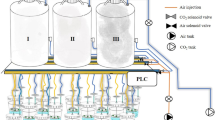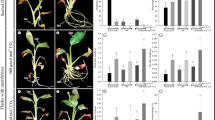Abstract
Growth and propagation rates, hyperhydricity percentages, macronutrientabsorption and pH evolution were evaluated in Dianthuscaryophyllus CV Nelken cultured in vitro under different ventilationconditions. Culture in well ventilated conditions (HVC) i.e. low relativehumidity, generated lower percentages of hyperhydric explants, with highermicropropagation coefficients and dry weight increments, than in less ventilatedcultures (LVC). Macronutrient absorption was similar in both types of cultures,except for ammonium, nitrate, chloride and phosphate. In LVC, after 15 days ofculture, carnation explants absorbed more nitrate than ammonium and chlorideuptake was 5 times greater than in HVC. Phosphate uptake was more pronounced inLVC after 15 days of culture, reaching similar values in both types of culturevessels at the end of the experiment, and led to growth limiting conditions formore prolonged cultures. Medium pH decreased to acid values after 15 days ofculture and even more at the end of the experiment; however, these acidconditions seem not be an obstacle for nutrient absorption.
Similar content being viewed by others
References
Barbas E., Chaillou S., Cornu D., Doumas P., Jay-Allemand C. and Lamaze T. 1993. Ortophosphate nutrition of in vitro propagated hybrid walnut (Juglans nigra × Juglans regia) trees: Pi (32Pi) uptake and transport in relation to callus and shoot development. Plant Physiol. Biochem. 31: 41–49.
Cuello J.L., Walker P.N. and Heuser C.V. 1992. Controlled in vitro environment for stage II micropropagation of Chrysanthemum. Trans. Am. Soc. Agri. Eng. 35: 1079–1083.
Daguin F. and Letouze R. 1986. Ammonium-induced vitrification in cultured tissues. Physiol. Plant. 66: 94–98.
Dantas A.K., Cañal M.J., Centeno M.L., Feito I. and Fernández B. 1997. Endogenous plant growth regulators in carnation tissue cultures under different conditions of ventilation. Plant Growth Regul. 22: 169–174.
Debergh P., Aitken-Christie J., Cohen D., Grout B., Von Arnol S., Zimmerma R. et al. 1992. Reconsideration of the term vitrification as used in micropropagation. Plant Cell Tiss. Org. Cult. 30: 135–140.
Desamero N.V., Adelberg J.W., Hale A., Young R.E. and Rhodes B.B. 1993. Nutrient utilisation in liquid/membrane system for watermelon micropropagation. Plant Cell Tiss. Org. Cult. 33: 265–271.
Dillen W. and Buysen S. 1989. A simple technique to overcome vitrification in Gypsophila paniculata L. Plant Cell Tiss. Org. Cult. 19: 181–188.
Dussert S., Verdeil J.L., Rival A., Noirot M. and Buffard-Morel J. 1995. Nutrient uptake and growth of in vitro coconut (Cocos nucifera L) calluses. Plant Sci. 106: 185–193.
Gaspar T., Kevers C., Debergh P., Maene L., Paques M. and Boxus P. 1987. Vitrification: morphological, physiological and ecological aspects. In: Bonga J.M. and Durzan D.J. (eds), Cell and Tissue Culture in Forestry. Martinus Nijhoff Publishers, Dordrecht, pp. 152–166.
Kataeva N.V., Alexandrova I.G., Butenbo R.G. and Dragavteeva E.V. 1991. Effect of applied and internal hormones on vitrification and apical necrosis of different plants cultured in vitro. Plant Cell Tiss. Org. Cult. 27: 149–154.
Kevers C. and Gaspar T. 1986. Vitrification of carnation in vitro-:changes in water content, extracellular air space volume and ion levels. Physiol. Vég. 24: 647–653.
Kozai T., Fujiwara K. and Watanabe I. 1986. Fundamental studies on environments in plant tissue culture vessels: effects of stoppers and vessels on gas exchange rates between inside and outside of vessels closed with stoppers. J. Agric. Meteorol. 42: 119–127.
Leifert C., Murphy K.P. and Lumsden P.J. 1995. Mineral and carbohydrate nutrition of plant cell and tissue cultures. Crit. Rev. Plant Sci. 14: 83–109.
Leshem B., Werker E. and Shalv P.D. 1988. The effect of cytokinins on vitrification in melon and carnation. Ann. Bot. 62: 271–276.
Majada J.P., Fal M.A. and Sánchez-Tamés R. 1997. The effect of ventilation on proliferation and hyperhydricity of Dianthus caryophyllus L. Vitro. Cell Dev. Biol. 33: 62–69.
Mezzetti B., Rosati P. and Giovanni C. 1991. Actinidia deliciosa CF Liang in vitro. Plant Cell Tiss. Org. Cult. 25: 91–98.
Miflin B.J. and Lea P.J. 1976. The pathway of nitrogen assimilation in plants. Phytochemistry. 15: 873–885.
Moncalean P., Cañal M.J., Feito I., Rodriguez A. and Fernandez B. 1999. Cytokinins and mineral nutrition in Actinidia deliciosa (Kiwi) shoots cultured in vitro. J. Plant Physiol. 155: 606–612.
Murashige T. and Skoog F. 1962. A revised medium for rapid growth and bioassays with tobacco tissue cultures. Physiol. Plant. 15: 473–497.
Nour K.A. and Thorpe T.A. 1994. The effect of the gaseous state on bud induction and shoot multiplication in vitro in eastern white cedar. Physiol. Plant. 90: 163–172.
Owen H.R., Wengerd D. and Miller A.R. 1991. Culture medium pH is influenced by basal medium, carbohydrate source, gelling agent, activated charcoal and medium storage method. Plant Cell Rep. 10: 583–586.
Quorin M. and Lepoivr P. 1997. Étude de milieux adapté aux cultures in vitre de Prunus. Acta Hort. 78: 437–442.
Salsac L., Chaillou S., Morot-Gaudry J.F., Lesaint C. and Jolivet E. 1987. Nitrate and ammonium nutrition in plants. Plant Physiol. Biochem. 25: 805–812.
Sallanon H. and Maziere Y. 1992. Influence of growth room and vessel humidity on the in vitro development of rose plants. Plant Cell Tiss. Org. Cult. 30: 121–125.
Singha S., Oberly G.H. and Towsend E.C. 1987. Changes in nutrient composition and pH of the culture medium during in vitro shoot proliferation of crab apple and pear. Plant Cell. Tiss. Org. Cult. 11: 209–220.
Skirvin R.M., Chu M.C., Mann M.L., Young H., Sullivan J. and Fermanian T. 1986. Stability of tissue culture medium as a function of autoclaving time and cultured plant material. Plant Cell. Rep. 5: 292–294.
Williams R.R. 1993. Mineral nutrition in vitro-a mechanistic approach. Aust. J. Bot. 41: 237–251.
Williams R.R., Taji A.M. and Winney K.A. 1990. The effect of Ptilotus plant tissue on pH of in vitro media. Plant Cell. Tiss. Org. Cult. 22: 153–158.
Ziv M. 1991. Vitrification: morphological and physiological disorders of in vitro plants. In: Debergh P.C. and Zimmerman R.H. (eds), Micropropagation. Technology and Application. Kluwer Academic Publ, Dordrecht, pp. 45–69.
Ziv M. and Ariel T. 1988. The relationship between cell wall deformity and stomatal malfunction in the leaves of carnation in vitro. In:, Proc. Intl. Soc. Plant Mol. Biol. Congress., Jerusalem, p. 425. 243
Author information
Authors and Affiliations
Rights and permissions
About this article
Cite this article
Dantas, A., Majada, J., Fernández, B. et al. Mineral nutrition in carnation tissue cultures under different ventilation conditions. Plant Growth Regulation 33, 237–243 (2001). https://doi.org/10.1023/A:1017542106252
Issue Date:
DOI: https://doi.org/10.1023/A:1017542106252




